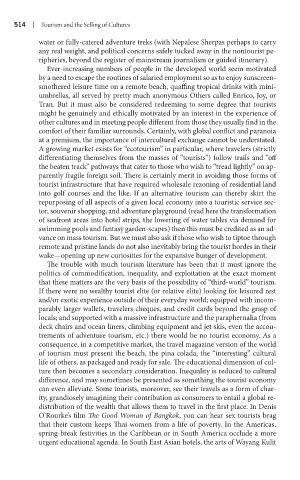Page 535 - Battleground The Media Volume 1 and 2
P. 535
1 | Tour sm and the Sell ng of Cultures
water or fully-catered adventure treks (with Nepalese Sherpas perhaps to carry
any real weight, and political concerns safely tucked away in the nontourist pe-
ripheries, beyond the register of mainstream journalism or guided itinerary).
Ever-increasing numbers of people in the developed world seem motivated
by a need to escape the routines of salaried employment so as to enjoy sunscreen-
smothered leisure time on a remote beach, quaffing tropical drinks with mini-
umbrellas, all served by pretty much anonymous Others called Enrico, Joy, or
Tran. But it must also be considered redeeming to some degree that tourists
might be genuinely and ethically motivated by an interest in the experience of
other cultures and in meeting people different from those they usually find in the
comfort of their familiar surrounds. Certainly, with global conflict and paranoia
at a premium, the importance of intercultural exchange cannot be understated.
A growing market exists for “ecotourism” in particular, where travelers (strictly
differentiating themselves from the masses of “tourists”) follow trails and “off
the beaten track” pathways that cater to those who wish to “tread lightly” on ap-
parently fragile foreign soil. There is certainly merit in avoiding those forms of
tourist infrastructure that have required wholesale rezoning of residential land
into golf courses and the like. If an alternative tourism can thereby skirt the
repurposing of all aspects of a given local economy into a touristic service sec-
tor, souvenir shopping, and adventure playground (read here the transformation
of seafront areas into hotel strips, the lowering of water tables via demand for
swimming pools and fantasy garden-scapes) then this must be credited as an ad-
vance on mass tourism. But we must also ask if those who wish to tiptoe through
remote and pristine lands do not also inevitably bring the tourist hordes in their
wake—opening up new curiosities for the expansive hunger of development.
The trouble with much tourism literature has been that it must ignore the
politics of commodification, inequality, and exploitation at the exact moment
that these matters are the very basis of the possibility of “third-world” tourism.
If there were no wealthy tourist elite (or relative elite) looking for leisured rest
and/or exotic experience outside of their everyday world; equipped with incom-
parably larger wallets, travelers cheques, and credit cards beyond the grasp of
locals; and supported with a massive infrastructure and the paraphernalia (from
deck chairs and ocean liners, climbing equipment and jet skis, even the accou-
trements of adventure tourism, etc.) there would be no tourist economy. As a
consequence, in a competitive market, the travel magazine version of the world
of tourism must present the beach, the pina colada, the “interesting” cultural
life of others, as packaged and ready for sale. The educational dimension of cul-
ture then becomes a secondary consideration. Inequality is reduced to cultural
difference, and may sometimes be presented as something the tourist economy
can even alleviate. Some tourists, moreover, see their travels as a form of char-
ity, grandiosely imagining their contribution as consumers to entail a global re-
distribution of the wealth that allows them to travel in the first place. In Denis
O’Rourke’s film The Good Woman of Bangkok, you can hear sex tourists brag
that their custom keeps Thai women from a life of poverty. In the Americas,
spring-break festivities in the Caribbean or in South America occlude a more
urgent educational agenda. In South East Asian hotels, the arts of Wayang Kulit

